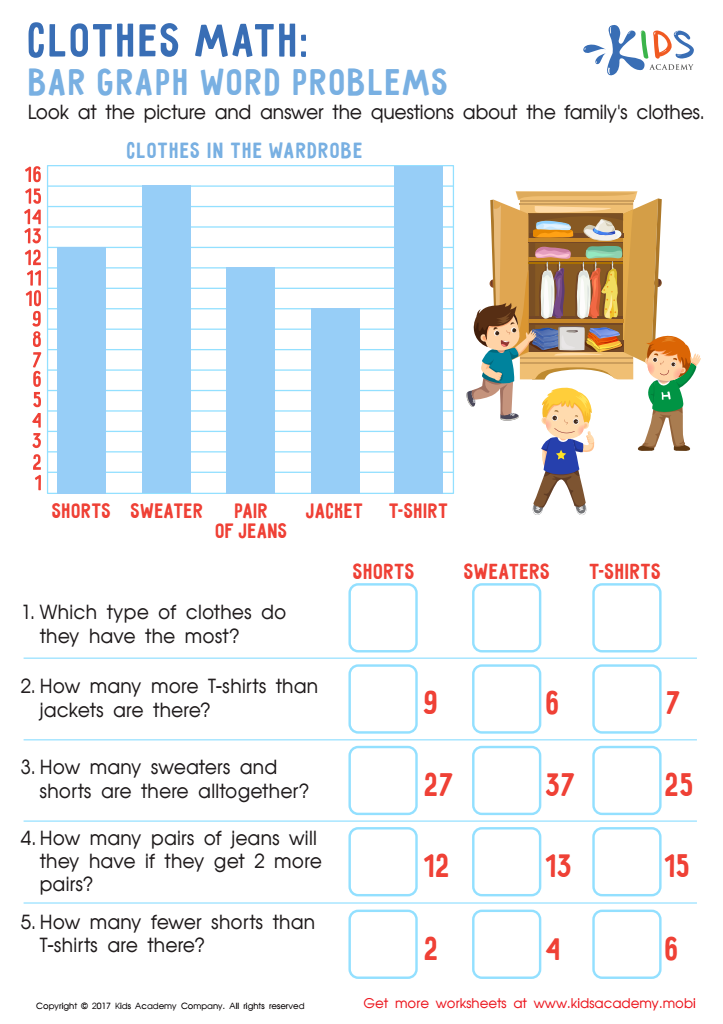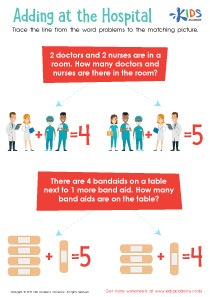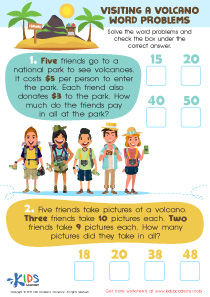Normal Graph Word Problems Worksheets for 7-Year-Olds
1 filtered results
-
From - To
Introducing our School Interactive Worksheets featuring Normal Graph Word Problems, tailored specifically for seven-year-old students! These engaging worksheets are designed to introduce young learners to the basics of graph interpretation and data analysis through a series of fun and relatable word problems. Each sheet is crafted to captivate children's interest while enhancing their mathematical skills and comprehension. Ideal for both classroom and home use, these worksheets encourage interactive learning and critical thinking. Watch your child develop confidence in handling data and gain a solid foundation in essential math concepts with our carefully structured activities. Equip your young learner for academic success today!


Clothes Math: Bar Graph Word Problems Worksheet
Normal worksheets on graph word problems are an indispensable tool in the educational toolkit for young learners, especially those around the age of seven. These resources not only enhance mathematical ability but also integrate reading and comprehension skills, making them ideal for comprehensive learning.
Graph word problems are particularly engaging because they combine visual elements with analytical challenges. This form of learning can be especially effective for young students who may find traditional numerical problems less engaging. By using school interactive printables that focus on graph word problems, educators can provide a dynamic learning experience that encourages children to explore math in a context that feels more like a game than a classroom exercise.
The use of school interactive printables for teaching graph word problems offers numerous benefits. First, these materials are designed to be child-friendly. They often include colorful graphs and interesting scenarios that relate to real-world situations children can understand and find intriguing. For example, a worksheet might present a graph showing the number of apples and oranges sold at a market over a week, asking the child to analyze which fruit was more popular. This approach helps children make practical connections between what they are learning and how it applies outside the classroom.
Additionally, graph word problems help develop critical thinking and problem-solving skills. When children work on these worksheets, they learn not only to read graphs but also to interpret the information they present. This requires them to think logically and make deductions, which are crucial skills in any field of study. They also learn to follow instructions carefully and to communicate their findings effectively, often needing to explain how they arrived at their answers.
Furthermore, school interactive printables are designed to be used interactively. Many of these resources can be used in group settings, where children collaborate to solve problems. This not only makes the learning process more engaging but also helps in developing social skills like communication, cooperation, and negotiation. In a classroom setting, these interactive sessions can turn learning into a fun and collective effort, which can be particularly motivating for young students.
Another significant advantage of these printables is that they can be tailored to individual learning paces. For children who might find certain concepts challenging, these worksheets can provide additional practice in a stress-free manner, allowing them to master the skills at their own speed. Conversely, for students who grasp the concepts quickly, more complex problems can be introduced to keep them challenged and engaged.
Incorporating technology enhances these benefits further. Many school interactive printables can be accessed digitally, making them an excellent tool for virtual learning environments or for integrating technology into the classroom. Digital worksheets can include interactive elements such as drag-and-drop features, clickable tabs that reveal more information, or even short instructional videos embedded within the worksheet itself. This not only captures the interest of tech-savvy children but also caters to various learning styles—whether auditory, visual, or kinesthetic—making the learning experience more inclusive and effective.
Moreover, digital versions of these graph word problem worksheets often come with instant feedback mechanisms. For example, when a child inputs an answer, the system might immediately indicate whether the answer is correct or provide hints leading them to the correct solution. This immediate feedback is invaluable as it helps children learn from their mistakes in real-time and reinforces the learning process.
Additionally, using school interactive printables reduces the environmental footprint associated with traditional paper-based learning materials. By transitioning to digital resources, schools can decrease paper waste, aligning educational practices with the principles of sustainability and environmental responsibility.
Parents also find these resources particularly helpful. They are able to understand and track their children's progress through the use of these printables. Many platforms offering these worksheets provide parent portals where they can view completed assignments, check scores, and sometimes even observe the learning process in real-time. This makes it easier for parents to be involved in their child’s education, supporting and encouraging them along the way.
Lastly, these worksheets are designed to be flexible. They can be used as part of homework assignments, classroom activities, or even during special math-focused sessions or clubs. This flexibility makes it easier for educators to integrate them into any curriculum plan, ensuring that graph interpretation and problem-solving skills are reinforced regularly and effectively.
In conclusion, school interactive printables focusing on graph word problems are more than just worksheets—they are a comprehensive educational tool designed to engage, educate, and excite seven-year-old students about math. By blending visual, interactive, and practical elements, these resources make learning accessible and fun, setting a solid foundation in mathematical, analytical, and critical thinking skills that will benefit children throughout their schooling and beyond.
 Assign to My Students
Assign to My Students












